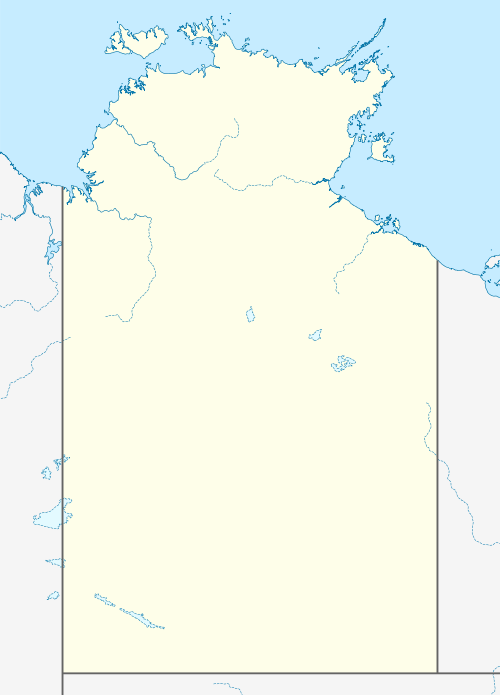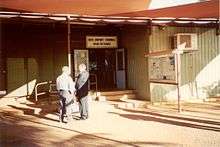Nhulunbuy
Nhulunbuy is a township that is the sixth largest place in the Northern Territory of Australia. Nhulunbuy was created on the Gove Peninsula when a bauxite mine, and a deep water port, were established in the late 1960s, followed by an alumina refinery.[2] At the 2016 census, Nhulunbuy had a population of 3,240 with a median age of 32.[3]
| Nhulunbuy Northern Territory | |||||||||
|---|---|---|---|---|---|---|---|---|---|
 Nhulunbuy | |||||||||
| Coordinates | 12°10′57″S 136°46′55″E | ||||||||
| Population | 3,240 (2016 census)[1] | ||||||||
| • Density | 455.1/km2 (1,178.6/sq mi) | ||||||||
| Postcode(s) | 0881, 0880 | ||||||||
| Elevation | 20 m (66 ft) | ||||||||
| Area | 7.12 km2 (2.7 sq mi) | ||||||||
| Location |
| ||||||||
| LGA(s) | Unincorporated area | ||||||||
| Territory electorate(s) | Nhulunbuy | ||||||||
| Federal Division(s) | Lingiari | ||||||||
| |||||||||

The alumina refinery closed in May 2014, which resulted in 1,100 workers being redeployed or made redundant,[4] and reduced the Nhulunbuy population by 700 to 3,240 in the 2016 census.[1]
In 2019 a new Arnhem Space Centre near Nhulunbuy, an equatorial satellite launch facility, was announced.[5]
History
This area in Northeast Arnhem Land has been home to the Yolngu Aboriginal people for at least 40,000 years.
Matthew Flinders, in his circumnavigation of Australia in 1803, met the Macassan trading fleet near present-day Nhulunbuy, an encounter that led to the establishment of settlements on Melville Island and the Cobourg Peninsula. A beach close to the township is named Macassan Beach in honour of this encounter.
In 1963, a Federal government decision excised part of the land for a bauxite mine to be operated by the North Australian Bauxite and Alumina Company (Nabalco).[6] The Yolngu Aborigines at Yirrkala were strongly opposed, and forwarded a bark petition to the Australian House of Representatives, which attracted national and international attention, and which now hangs in Parliament House, Canberra.[7][6]
To serve the mine, the town of Nhulunbuy was established, housing the workers and their families employed by Nabalco, which became Alcan in 2002. In 2003, Alcan Gove issued a notice of intent to Government of the Northern Territory re third stage expansion of the alumina refinery.[8] During the 1970s, the population rose to approximately 3,500 with 1,000 students at the combined primary and high school. A new high school was opened in 1981. The mine was later owned by Rio Tinto, which acquired Alcan in 2007.
Permits are required to drive to Nhulunbuy — over 700 km of unsealed roads — so most supplies and visitors are brought by air to Gove Airport or by sea.
Nhulunbuy is only 20 km from the Indigenous community of Yirrkala, famous for its Aboriginal art.
For the purposes of granting tax rebates to residents of isolated areas as per Section 79A(3F) of the Income Tax Assessment Act 1936, the census population of Nhulunbuy is taken to be less than 2,500,[9] although it was in fact 3,240 in the 2016 census.[1]
Education
Nhulunbuy includes three schools; Nhulunbuy Primary School, Nhulunbuy High School and Nhulunbuy Christian College. In 1999, the first classes of the Nhulunbuy Christian College (formerly known as Nhulunbuy Christian School) were held at the local TAFE centre, and in 2001 the first building of the new school was completed. In 2007 the NCC Middle School was opened and in 2008 the combined year 8/9 Class was first established.
Facilities
- Walkabout Lodge & Tavern
- Dhimurru Aboriginal Corporation
- Endeavour Square, a community shopping centre that includes the northernmost Woolworths supermarket, BWS liquor store and Westpac bank in Australia
- Gove Country Golf Club; northernmost golf course in Australia
- Gove District Hospital
- Gove Boat Club
Refinery closure
On 29 November 2013, Rio Tinto announced the closure of the alumina refinery (but not the bauxite mine) by July 2014 with the loss of 1,100 jobs, or almost 25% of the town's population.[4][10] The refinery ceased production in May 2014.[11]
Nhulunbuy's population had already dropped by mid 2014, with some of the workforce retained to monitor the shutdown and survey holding ponds full of toxic compounds, but most will be gone by January 2015.[2][2] A range of measures were announced to support the town and its former workers through the closure and the following three years, but locals anticipate further cuts to services since the school, hospital, power plant and flights were backed by Rio Tinto.[12] The closure of the refinery also left flights on the Darwin-Nhulunbuy route to fall to around 50 to 60 per cent full, causing QantasLink to suspend flights on the route from 17 August 2014.[13]
Media
As a result of the refinery curtailment and subsequent loss of advertising revenue, Gove's only source of local news, The Arafura Times, published its final issue in mid-October 2016.[14]
In response to the closure of, Gove Online (http://www.goveonline.com.au) a not-for-profit community-led online initiative was established in December 2016, to offer an alternative source of local news, to promote the local region to a wider audience.
Climate
| Climate data for Nhulunbuy | |||||||||||||
|---|---|---|---|---|---|---|---|---|---|---|---|---|---|
| Month | Jan | Feb | Mar | Apr | May | Jun | Jul | Aug | Sep | Oct | Nov | Dec | Year |
| Record high °C (°F) | 35.7 (96.3) |
35.6 (96.1) |
35.7 (96.3) |
35.6 (96.1) |
34.0 (93.2) |
32.3 (90.1) |
31.2 (88.2) |
33.4 (92.1) |
34.6 (94.3) |
37.8 (100.0) |
37.3 (99.1) |
35.3 (95.5) |
37.8 (100.0) |
| Average high °C (°F) | 32.0 (89.6) |
31.7 (89.1) |
31.5 (88.7) |
31.5 (88.7) |
30.5 (86.9) |
29.5 (85.1) |
28.6 (83.5) |
29.0 (84.2) |
29.8 (85.6) |
30.9 (87.6) |
31.9 (89.4) |
32.4 (90.3) |
30.8 (87.4) |
| Daily mean °C (°F) | 28.8 (83.8) |
28.5 (83.3) |
28.2 (82.8) |
27.8 (82.0) |
26.9 (80.4) |
25.5 (77.9) |
24.6 (76.3) |
24.5 (76.1) |
25.5 (77.9) |
26.9 (80.4) |
28.5 (83.3) |
29.2 (84.6) |
27.1 (80.7) |
| Average low °C (°F) | 25.5 (77.9) |
25.2 (77.4) |
24.9 (76.8) |
24.0 (75.2) |
23.2 (73.8) |
21.5 (70.7) |
20.5 (68.9) |
19.9 (67.8) |
21.1 (70.0) |
22.9 (73.2) |
25.1 (77.2) |
25.9 (78.6) |
23.3 (73.9) |
| Record low °C (°F) | 20.5 (68.9) |
22.0 (71.6) |
17.2 (63.0) |
20.5 (68.9) |
17.3 (63.1) |
15.5 (59.9) |
14.6 (58.3) |
14.0 (57.2) |
16.3 (61.3) |
15.1 (59.2) |
20.0 (68.0) |
21.2 (70.2) |
14.0 (57.2) |
| Average rainfall mm (inches) | 233.9 (9.21) |
241.7 (9.52) |
260.6 (10.26) |
237.1 (9.33) |
83.9 (3.30) |
17.8 (0.70) |
13.3 (0.52) |
4.1 (0.16) |
4.2 (0.17) |
12.0 (0.47) |
27.0 (1.06) |
189.9 (7.48) |
1,305.3 (51.39) |
| Average rainy days | 15.1 | 15.6 | 15.5 | 12.5 | 8.9 | 5.7 | 4.4 | 2.2 | 1.2 | 1.6 | 2.7 | 9.7 | 95.1 |
| Average afternoon relative humidity (%) | 72 | 73 | 73 | 68 | 65 | 61 | 61 | 61 | 61 | 62 | 66 | 69 | 66 |
| Source: [15] | |||||||||||||
References
- Australian Bureau of Statistics (27 June 2017). "{{{name}}}". 2016 Census QuickStats. Retrieved 11 April 2018.

- https://www.theguardian.com/world/2014/aug/11/-sp-boom-to-dust-uncertain-future-for-town-run-by-rio-tinto
- http://quickstats.censusdata.abs.gov.au/census_services/getproduct/census/2016/quickstat/SSC70208?opendocument
- Perry, Juliet (21 October 2014). "Voices from Gove: Can a mining town survive a shutdown?". BBC News. Retrieved 22 October 2014.
- "NASA's surprise Aussie pick for rocket launch". NewsComAu. 31 May 2019. Retrieved 1 June 2019.
- "Novel Plea By Tribal Group". 15 August 1963. Retrieved 8 July 2017.
- Stewart, Heather; Rawlinson, Clare (10 July 2013). "Yirrkala bark petitions: A turning point in recognition of Indigenous rights". ABC. Retrieved 8 July 2017.
- "Alcan Gove Alumina Refinery Third Stage Expansion Notice of Intent" (PDF). Alcan. 1 March 2003. Retrieved 17 August 2019.
- "INCOME TAX ASSESSMENT ACT 1936 - SECT 79A". Australian Government. Retrieved 11 January 2015.
- McGrath, Pat (29 November 2013). "About 1,100 jobs cut as Rio Tinto suspends production at Gove alumina refinery in the Northern Territory". ABC Online. Retrieved 12 February 2014.
- "Rio Tinto delivers another strong quarterly production performance" (PDF). Rio Tinto. 15 October 2014. Archived from the original (PDF) on 31 December 2014. Retrieved 23 May 2015.
- McGrath, Pat (29 November 2013). "Rio Tinto reveals rescue package for future of Nhulunbuy after alumina refinery closure". ABC Online. Retrieved 12 February 2014.
- Tsang, Daniel (7 August 2014). "Qantas faces defining moment". Aspire Aviation. Retrieved 21 August 2014.
- "East Arnhem Land newspaper 'Arafura Times' closes down". NITV. Retrieved 10 April 2018.
- "Nhulunbuy DTW". Climate statistics for Australian locations. Bureau of Meteorology. Retrieved 26 November 2011.
External links
- Alcan History of Region archive 2008-07-19
- Lirrwi Tourism Organisation
- Nhulunbuy - Topic - ABC News
- Nhulunbuy Corporation manages the township of Nhulunbuy